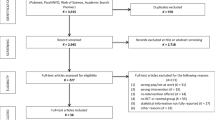Abstract
Cognitive approaches to training for the detection of improvised explosive devices (IED’s) are of increasing importance. However, there is a question as to the degree to which such training might interfere with other important law enforcement (LE) functions in the field, and the degree to which such training might enhance other important cognitive/perceptual functions. A promising cognitive approach to IED training, the SMOKE system, was provided to respondents, who then responded to shoot/no-shoot decisions, important LE situations of increasing relevance. It was shown that SMOKE training did not interfere with shoot/no-shoot decisions. However, those with SMOKE training performed better than control respondents on eyewitness memory for the perpetrator of a given crime in field-valid scenes. This indicates that cognitively based training may enhance vigilance and resultant memory in field situations.
Similar content being viewed by others
References
Boring EG (1957) A history of experimental psychology, 2nd edn. Appleton, New York
Bransford JD, Johnson MK (1973) Contextual prerequisites for understanding: Some investigations of comprehension and recall. In: Chase WG (ed) Visual information processing. Academic Press, Orlando
Collins AM, Loftus EF (1975) A spreading activation theory of semantic processing. Psychol Rev 82:407–428
Correll J, Park B, Judd CM, Wittenbrink B, Sadler MS, Keesee T (2007) Across the thin blue line: police officers and racial bias in the decision to shoot. J Pers Soc Psychol 92:1006–1023
Department of Justice (1999) Eyewitness evidence: a guide for law enforcement. Office of Justice Programs, National Institute of Justice, Washington, DC
Grossman D, Christensen LW (2004) On combat. PPCT Research Publications
Haviland SE, Clark HH (1974) What’s new? Acquiring new information as a process of comprehension. J Verbal Learn Verbal Behav 13:512–521
Herrera MR, Sharps MJ, Swinney HR, Lam J (2015) Deadly force or not? Visual and cognitive interpretation of rifles and BB guns in crime-scene context. J Police Crim Psychol 30:254–260
Klinger D (2004) Into the kill zone: a cop’s eye view of deadly force. Josey-Bass, San Francisco
Mandler G (2011) From association to organization. Curr Dir Psychol Sci 20:232–235
Montejano, D. (2004, November). Fresno police department conference on stress in police work. Fresno, CA
Moore L (2006) Conference on the use of force in law enforcement. Office of the United States Marshall, Fresno
Sharps MJ (2017) Processing under pressure: stress, memory, and decision-making in law enforcement, 2nd edn. Looseleaf Law, Flushing
Sharps MJ, Hess AB (2008) To shoot or not to shoot: response and interpretation of response to armed assailants. Forensic Examiner 17:53–64
Sharps MJ, Nunes MA (2002) Gestalt and feature-intensive processing: toward a unified theory of human information processing. Curr Psychol 21:68–84
Sharps MJ, Newborg E, Glaser M, Hayward B, Scholl M (2010) Finding IED’s before they find you: the SMOKE system of training for hazardous device detection. Forensic Examiner 19:48–59
Sharps MJ, Herrera MG, Lodeesen AL (2014) SMOKE: effective cognitive and field training for IED detection. Inside Homeland Security, 2, 9 pgs., http://www.abchs.com.ihs/SUMMER 2014/ihs_articles_5.php, DOI pending. (simultaneously published online in Forensic Examiner, 23, 7 pgs.)
Funding
Portions of this research were funded by a portion of a $5000 Summer Salary granted to the first author by the College of Science and Mathematics, California State University, Fresno.
Author information
Authors and Affiliations
Corresponding author
Ethics declarations
Conflict of Interest
The authors declare that they have no conflict of interest.
Ethical Approval
This project received full ethical approval from the Human Subjects Committee, Department of Psychology, College of Science and Mathematics, California State University, Fresno. The project was approved as a “minimal risk” procedure for human subjects.
Informed Consent
All human subjects of this research were provided with full informed consent according to the ethical standards of the American Psychological Association, standard for this field. All were adults, and all indicated that they had fully read the Informed Consent form and the research descriptions contained therein, and signed the form to give their consent to participate in the study.
Appendix 1
Appendix 1
Brief Descriptions of the Five Error Types Addressed in the SMOKE System (summarized from Sharps 2017).
-
1.
S- errors of SEARCH. For this error type, respondents focused on only one part of the environment in which mock-IEDs were deployed, or only on one plane, failing to look up or down.
-
2.
M- errors of MOVEMENT. Some respondents remained in one place in the environment (a moderately cluttered room), frequently at the door. So, many areas of the room, behind and under things, were completely invisible to them; often there was no tendency to move about the room in an effort to take different necessary visual perspectives.
-
3.
O- errors of OBSERVATION. In these errors, respondents looked directly at a given IED but did not report it, moving on to look at other things. This frequently happened with large, very visible IEDs. Respondents who made errors of Observation looked directly at IEDs clearly in view, and saw nothing dangerous at all.
-
4.
K- failures to KEEP SEARCHING. In these instances, respondents might find a single bomb, or they might identify an innocuous object as a bomb, and then decide they had found everything there was to find. Respondents would report that they were finished looking, even in the presence of additional devices which remained undetected.
-
5.
E- errors of EVALUATION. These occurred when respondents identified innocuous objects (such as a briefcase or a pillow) as IEDs. Some of these objects were plausible disguises for IEDs; others were not, ranging from the implausible to the absurd. What is important about these errors, however, is that they occurred when the actual mock-IEDs were in plain sight.
Rights and permissions
About this article
Cite this article
Sharps, M.J., Herrera, M.R., Hulett, D.L. et al. Shoot/No-Shoot Decisions in the Context of IED-Detection Training and Eyewitness Memory for Persons. J Police Crim Psych 33, 327–331 (2018). https://doi.org/10.1007/s11896-018-9283-z
Published:
Issue Date:
DOI: https://doi.org/10.1007/s11896-018-9283-z




